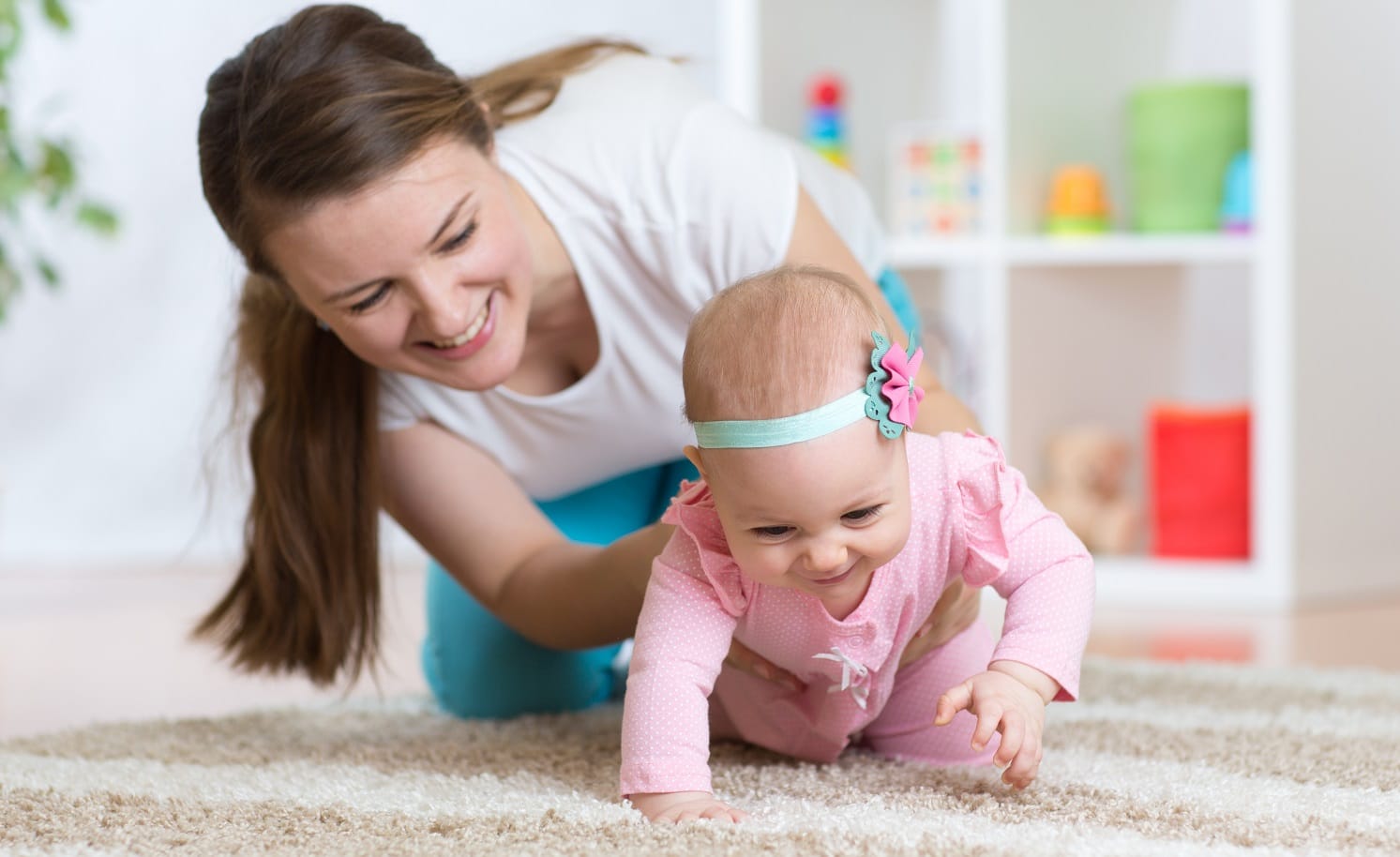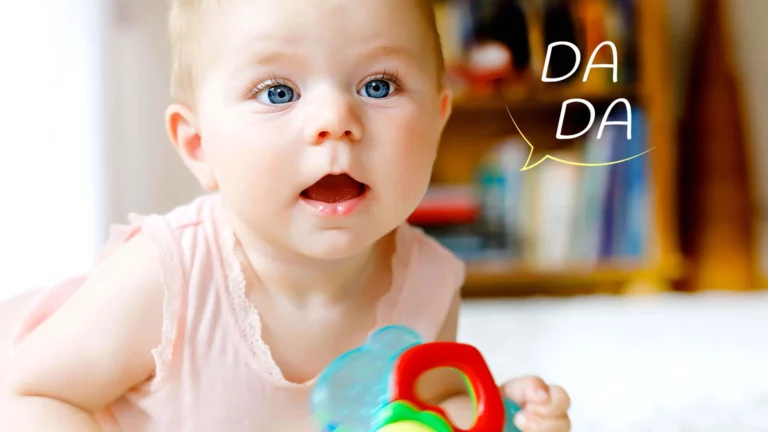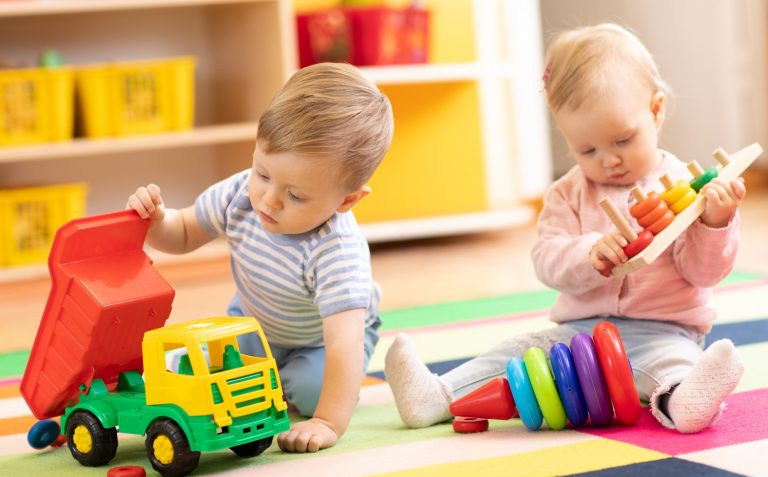It’s a common misconception that crawling is the natural progression from sitting to standing. In reality, babies first learn to scoot themselves by pushing off with their legs and dragging themselves forward. One of the most exciting or developmental milestones experienced for babies in their first year is learning how to crawl.
Baby crawling can be challenging for both parents and the baby itself. But it’s important to remember that there are many things you can do to help make this milestone easier for everyone involved. Most parents want their children to be able to crawl as soon as possible. But not everyone knows how to help a baby crawl. This blog post will share helpful tips and tricks on how you can encourage your child to crawl faster.
In This Article
- 8 ways or activities to help the baby crawl!!
- 1. Tummy Time
- 2. Use toys to encourage crawling
- 3. Use a tunnel
- 4. Twist and turn
- 5. Provide the room to move
- 6. Bouncing/Swinging
- 7. Belly Bait
- 8. Get your babies to crawl outside
- How to encourage a baby to crawl?
- What are the signs of a baby crawling?
- What ages should a baby do learn to crawl?
- What are the different types of baby crawling?
8 ways or activities to help the baby crawl!!
Most babies begin crawling at around 9 months, but it can start as early as 6 or as late as 14. Baby’s love of movement is a huge hoopla in the parenting world and this is the stage of baby’s development. Well, there are many ways or activities parents should do to crawling baby and they are:
1. Tummy Time
Tummy time is recommended for all babies because it helps to develop the baby’s head and neck muscles. For babies that are 6-12 months or older, tummy time is a great way to get your baby crawling or moving. Make sure the room is safe, place toys around the area and play with them during this time. This can be done in an awake state or when they’ve just woken up from naps/ sleep. If you find your baby is uninterested when they are on their tummy time. You can place them in different positions such as having them on their sides or knees. This is the classic crawl way for start crawling. It can also be done after changing diapers or during feeding time.
2. Use toys to encourage crawling
Make sure all the toys in your house are safe for the baby to crawl around. The most important thing is to put the toys within reach of your baby. They should be able to pick up the toy comfortably and not have a hard time reaching it. You can encourage them to move when playing with the toy. Place different kinds of toys near or beside them and try to make them reach out for it. But make sure they are not too far because it might frustrate them. Most babies just like to explore and move themselves.
3. Use a tunnel
There are play tunnels you can purchase or make your own. You’ll want to put a baby on the floor at the baby’s crawling level and sit next to the baby. Parents should use this activity to help their babies crawl when their tummy time has begun. If they don’t crawl into it right away, you can gently push them towards it with your hand. Building a tunnel out of couch pillows, blankets, or whatever you have around the house can create hours of play for infants. Place your baby in it and push toys through so they can bat them back and forth. It is the best activity when their tummy time begins. They have to reach for the toy then push themselves up onto their knees.
4. Twist and turn
Every motion starts from the center. This means when the baby is in a sitting position you can turn them in 360 degrees, this will help the baby to gain balance and strength. You can do this while the baby is still in a seated position or when they are on a play mat, but make sure there aren’t any toys nearby that might fall. You can make your baby more active by doing this after changing babies diaper. Your baby will be surprised and excited at the same time. Many babies would love twist and turns activities to encourage crawling baby.
5. Provide the room to move
To prepare for a crawling baby, you must provide a safe and free space to explore. No furniture or too many items in the room is an ideal setting. This can be done by giving the baby a designated play space or room. Perhaps where you have placed interesting objects that will entice them to crawl around. As we have already been told that a baby starts crawling typically in 9 months. And for babies is important to give them room to move. Put away the baby swing, bouncers, and walkers. Give them more space to get used to crawling. Babies tend to crawl everything in their path. So be careful about what you have around your house that can get broken or any sharp objects.
6. Bouncing/Swinging
Bouncing or swinging is recommended for babies that are 6-14 months. Babies love to bounce and that will help the baby go further with crawling. Swinging is great because it simulates the movement of crawling, also known as “creeping”. It can also be done by giving them swings or bouncy seats.
Many babies enjoy the sensation of being bounced so you do not have to go out and buy an expensive swing. The benefit of using a bouncer seat is that the baby feels safe and secure and there’s no need for supervision unless you use it outside. Bouncy seats or swings can be used as well, to stimulate crawling movement. This is done during feeding or tummy time because babies learns to bounce and swing while eating.
7. Belly Bait
Belly Bait activity said by medical experts that are important for promoting development in babies in order to learn how to crawl. Parents just need simple things, just lay down your baby on her back and hold their hands then slowly bring them forward until they are upon his or her belly. Do this activity about 5-10 times each time. Babies easily get bored with the same old toys and activities. So you can help them move around by placing new, colorful, and engaging objects for belly crawl towards.
8. Get your babies to crawl outside
Many babies start crawling outside of their homes. Because babies like to crawl outside, especially if it’s a gorgeous day. And there are many reasons why they should crawl in the great outdoors. Parks and playgrounds will encourage your child to take advantage of all that fresh air and sunshine (and beautiful views). Pushing and pulling toys and strollers help them practice moving around. Crawling outside also helps strengthen your baby’s arms and legs muscles. As well as stairs are one of the best ways for babies who want to begin crawling. So take them out for a walk at home or in the neighborhood and let them practice crawling up and down
How to encourage a baby to crawl?
Crawling is a first and exciting milestone that babies will reach, but many parents are struggling to figure out how to encourage crawling? How to help the baby crawl forward? How to strengthen baby’s legs to crawl? or how do babies learn to crawl? But above we have already discussed the serval activities for encourages babies to crawl. Though crawling may seem daunting to a baby, it can actually be pretty fun. And this is a thrill that will help build a strong foundation for the future.
Since there’s plenty of research that says crawling helps babies develop their core strength, arms, and legs coordination. The first time when a child learns to move on their own and explore their surroundings is the point when all the world becomes wonderful. While learning to crawl, babies try out how their limbs coordinate with each other and learn the balance.
However, not every child crawls right away. Some babies may need some encouragement from their parents before they’re ready to start exploring on their own. A great way to encourage a baby to crawl is by providing them with the right kind of flooring and furniture in their play area.
There are also things you can do with your hands that will make it easier for them to get around on their own. All of these will help your baby develop their crawling skill faster. In addition, the most important thing parents should know is that they should encourage babies to crawl from a young age for it provides great cognitive benefit in education and socialization.
What are the signs of a baby crawling?
By 6 or 9 months, babies are able to move their hands and knees in a crawling motion. They may actually scoot on the ground as they get closer to crawling for real. If you notice your baby pulling up on furniture or beginning to rock back and forth on their knees. Then they might be getting ready for the crawling position. Below we have discussed some common signs when a baby learn to crawl.
1. Baby starts to spend a lot of time on the floor
If your baby spends a lot of time on the floor, especially in a room full of things they can use to practice their crawling and cruising. Then it could be a sign of your baby getting ready to crawl. It could be because they have come up with a plan to get where they want to go. Sometimes when babies spend so much time doing tummy time, they start to want some time on their bellies. If your baby has no interest in doing this, it could be because they are trying to work out how to best get across the room.
2. Baby start standing on their own
If your baby has started pulling themselves up to stand, this could be a skill they are practicing in their crib. If you notice this happening more at bedtime than any other tummy time of day. It’s probably because he or she is trying out their new skills. The same goes for early-morning wake times. If your baby wakes up and stands in his or her crib before you get to them, it’s probably because they learn to crawl. Well, a putting baby to bed with a heavy blanket or pajama pants on the floor of the crib. Might give your baby something to practice holding onto when they start standing on their own.
3. Changing in sleeping patterns
Some babies, once they’ve mastered crawling, will scoot around on their bellies at night to get somewhere farther away. Other babies might start sleeping more through the night. This is not always the case with every baby, so if you notice a change in your child’s sleeping patterns it might be because of crawling. This is often why parents start noticing some changes in sleeping patterns. If your baby is moving more at night or even during naps. It’s likely they are working on new skills like motor skills and etc.
4. Pulling up to stand
This is normally around six and a half to seven months. Some babies will try to pull up on the couch or table around this time, which is your baby crawling preparation exercise. This is often called “cruising” as they like to practice standing with their right arm wrapped around something sturdy for balance. If you notice your little one doing this a lot, it might be time to get ready. most babies will start walking around 12 months, but some may take longer. The average baby will begin pulling themselves up between 8 and 10 months. It’s important to have things within reach so they have something to hold on to.
5. Looking at far away from playing objects
When babies begin crawling, they normally start by looking far away from playing objects. If your baby is in the 15-18 month range and has an interest in toys that are across the room. It might be time to get ready for them to crawl over to those objects. If you notice your baby looking as far as the end of the room, they might learn to move. For example, if you lay on the floor in front of your little one and they can see you, they might look towards you. If they don’t look at anything – or only stare at the ceiling lights, they might not be crawling yet.
What ages should a baby do learn to crawl?
A baby starts sitting up when they are about 5-6 months old. They sit unassisted around 8-10 months old. Baby moves or crawl is just flexing and extending one knee, which is also the motion of walking. But has done on hands and feet rather than both feet side by side. Although it is generally accepted that the average age for babies to start moving around on their own time is about 9 months old.
Crawling helps your baby in their motor development. According to academic research institutions if your baby doesn’t start crawling until 6 months then it would be perfectly normal. Sometimes baby extra body weight also affects to get them to stand by their own way.
So it would be better and advisable if you start crawling as soon as possible by giving them appropriate support. Sometimes parents skip crawling just because of their baby’s body weight or they don’t want to bother themselves. But if a baby learn to crawl early in their tummy time then here are many benefits of it. Which include better muscle development and body balance as well as more independence.
Babies who do not crawl can have difficulty with their motor skills later in life. This can be due to discomfort walking on their hands and knees. Some babies have poor muscle tone in their arms and legs may be the reason for starting crawling. There are also some temporary reasons this could happen, such as illness or injury. Once the baby has recovered from whatever is holding them back they will begin moving again. This is why it is important to seek medical attention for your child if they are not moved by the time when they are 9 months old.
What are the different types of baby crawling?
We all know that babies’ crawl is the main reason for motor milestones in their body development. And here are some crawling styles for your baby that can be useful in enhancing their motor and other skills and they are:
1. The tripod crawl
This type of crawling is when your baby will get on their hands and knees, resting with two knees and one hand down. Then push up so that they are in the quarter crawling sitting position. Your little one will then use their upper body to move forward while the lower half stays still. Criss-crossing the left arm across the chest can be used to stabilize the body as the right leg and then the left legs push forward simultaneously. This is a great technique that means your baby can explore their environment further.
2. Commando Crawl
Commando crawling is when your baby learns to crawl with a creeping tummy. Your little one will need to learn how to balance themselves. As they move forward by shifting their weight forward on straight arms or tucking the stomach in. A lot of children, especially if they are strong and not very flexible will start commando crawling first before they can manage to do the regular crawling position. As well as Army crawl is just as same as these crawling styles.
3. The bottom scoot
When babies learn to crawl, they will begin to explore the world from all angles. So this type of crawl is common as your little one learns how to go from a supine position on their backs or tummy to moving on hands and knees. And your baby play with their place toys without getting frustrating. In order to achieve this, your baby will sit up on their legs, catching them self with their hand. Then push down with their legs and scoot across the floor. Once your little one is comfortable with this form of a move, they may begin to rock side-to-side as well
4. Crab crawl
Your baby goes on all fours and then rocks back and forth, much like a crab. This crawling style is usually seen in children that are not ready to crawl or those with mobility issues. The crab crawl means your baby is on all fours but will not move forwards. They can do this with either one arm or two arms in front, when the crab crawl is done with both arms in front it’s called a bear crawl. But by making small movements, they turn their body around to look at an object they are interested in.
5. Bear Crawl
This type of crawling is when your baby will lift their body up into the push-up position. This is also known as army-style crawling. It’s a good technique for first steps or moving around on flat surfaces. This is when your baby learns to crawl like an animal. They will be on their belly with legs lifted up slightly, pushing off with one arm and pulling the arm forward. They then use arm strength to pull their chest forward and bring their knees up one at a time as they move along. It’s quite tiring for them but it works.
6. Leapfrog Crawl
This involves your baby lifting their back off the ground and going from all fours to a large C shape. This gives them a lot more mobility by being able to go further forward quickly. This is great for babies who are eager to move. It is a great way to get around with speed but may limit exploration in terms of close-up inspection or fine motor skills such as picking up toys. Leapfrog crawl is usually intermediate between basic crawl.
7. The roll Crawl
This is the way that babies crawl between 6-9 months of age. They get on to their hands and knees, then they use one hand to pull themselves forward while the other arm pushes the ground behind them. The rollover is an extension of this crawl. Just like when you are in a swimming pool, the roll Crawl will allow them to easily change direction with limited effort. In this crawling a baby’s body equally practice raising towards their move from one place to another.
The conclusion!!
The best way to help your babies learn to crawl is with a support system for loved ones. Provide them with plenty of encouragement and cheer leading as they move their little legs on the floor, one muscle at a time. Be sure that your child has plenty of time on their hands. As well as a safe space where they can explore without getting hurt or frustrated. We hope this article has helped you better understand why babies crawl and what to do when your baby isn’t crawling. If you have any other questions, please don’t hesitate to contact us through a comment.











